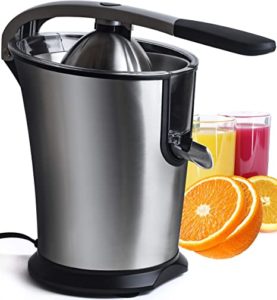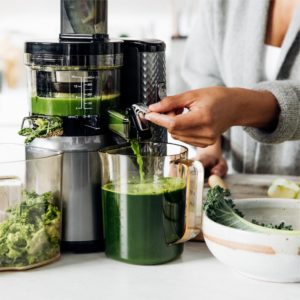Finding the ideal juicer for your needs can be long and complicated. The market is competitive, and as a result, most available models appear appealing for various reasons.
Most people are unaware that there are a variety of juicer designs, each with their strengths and weaknesses. These factors are the key to locating your ideal device; fortunately, we are well-versed in them.
This guide will break down the various juicer types currently available on the market to make your decision easier.
Choosing a Juicer Type
We realize that you probably don’t want to read about every type of juicer to determine which one is best for you. Instead, begin your journey by working your way down the following decision tree.
Through these preliminary questions, you should be able to determine which juicer style may be best for you, providing a starting point for further investigation.
Remember that virtually any juicer can juice any food. Therefore, if the best match on paper doesn’t work for you, don’t rule out all other styles simply because we haven’t recommended them.
If you require more specific guidance, please call us to speak with one of our many juicing specialists.
Juicers’ centrifugal or masticating
There are two primary types of juicers: centrifugal and masticating. The topic of which is superior has been discussed numerous times, but there is no clear winner because each has strengths and weaknesses. Therefore, you should base your decision on which juicer best meets your daily needs.
Let’s start by discussing centrifugal juicers. This type of juicer operates at speeds between 10,000 and 15,000 RPM (revolutions per minute), enabling it to process whole pieces of fruits and vegetables quickly.
It operates by tearing ingredients apart with a spinning blade. As the ingredients are processed, the juice can pass through a fine filter around the edge, while the remaining pulp is discarded.
The ability to operate at such a rapid rate enables centrifugal juicers to produce juice rapidly. However, doing so results in increased waste and diminished nutritional value.
Now that you understand how they function let’s examine a comprehensive list of the advantages and disadvantages of the centrifugal design style.
- Juices whole fruits without difficulty
- Very simple to use
- Produces juice quickly
- Typically priced between £100 and £300
- Very ineffective at juicing greens
- Usually has a shorter warranty duration
- Comparatively noisy to Masticating models
- fewer nutrients are extracted from foods.
- Rapid oxidation and degradation of juice.
In contrast to centrifugal models, which operate at high speeds, masticating juicers operate at low speeds. Sometimes referred to as slow juicers or cold presses, their rates range from 43 to 120 RPM. This slow operation enables them to extract incredibly high yields of juice from ingredients while preserving the juice’s nutrient content.
Consequently, this method has its advantages and disadvantages.
- Produces juices with high levels of vitamins and nutrients
- When used, juicers with low noise levels frequently serve additional purposes besides juicing.
- Juice is perishable after 72 hours
- Excellent at juicing all types of produce
- Extended guarantees of 5 to 15 years
- The best models typically cost more than $350.
- It produces juice gradually.
- Ingredients require preparation before juicing.
Masticating Juicer Styles
Unlike centrifugal juicers, masticating devices are available in various sizes and shapes. They are divided into three major categories to facilitate the selection process: vertical, horizontal, and twin gear.
Each style is distinct from the others and has advantages and disadvantages when working with ingredients.
Horizontal Juicers
Single-gear masticating juicers are by far the most popular we sell; they produce raw cold-pressed juice at an affordable price and frequently include various additional food processing features. Masticating juicers squeeze and press the juice slowly using an augur in a masticating process while the augur spins gradually between 50 and 120 RPM.
- Produces premium raw cold-pressed juice
- Produce abundant juice with dry pulp (only twin gear masticating juicers are better)
- Excellent at juicing leafy vegetables (only twin gear masticating juicers are better)
- Best value masticating juicers
- Most have warranties of 10 years or more
- Many have additional food processing capabilities, such as producing oils, nut butter, soya, nut milk, ice creams and sorbets, pasta, coffee, and ice grinding.
- Juices have a 24 to 72 hours shelf-life—exceptional all-purpose juicers for juicing fruits, vegetables, and greens.
- Extremely silent operation
- Typically, the most sluggish masticating juicers.
- Have the smallest feed chutes (usually 4cm in diameter).
- Most have a significant number of components to clean.
- It can only produce 1-2 liters per cycle before the juicer must be disassembled and cleaned.
Twin Gear Juicers
Twin gear juicers produce the highest yield of all available juicers. Twin Gear juicers are equipped with two augers that triturate the produce. Twin gear juicers are renowned for extracting juice from leafy greens and harder root vegetables. Still, they are poor at extracting juice from soft fruits such as oranges and pineapple compared to vertical masticating juicers.
- Give the highest yield of any juicers for leafy greens and vegetables. Excellent for wheatgrass.
- accompanied by solid guarantees
- Twin-gear juicers are more efficient than single-gear juicers
- They can break down produce more quickly, and their twin gears rotate between 90 and 150 RPMs faster.
- Extremely costly, with prices ranging between $450 and $1300
- Some juicers, such as the Angel
- Average at juicing soft fruits and requires a separate smooth juicing screen to extract juice from soft fruits effectively.
Vertical Juicers
Vertical masticating juicers, introduced in 2010, have taken the juicing world by storm and, according to many, have significantly contributed to the rise of cold-pressed juice in popular culture. Vertical Masticating Juicers were created with a simple goal: to make cold press juicing faster and easier. In a word, vertical masticating juicers are convenient. Vertical masticating juicers have imitated the vertical feeding design of high-speed centrifugal juicers and, as a result, have increased the masticating surface area, enabling more products to be juiced more quickly using the masticating method.
- Produces juice faster than competing masticating models.
- Very simple to use
- Simple construction Rapid cleaning procedure
- Expertise in juicing delicate fruits and tubers
- Minimalistic style
- Typically offered with accessories, including coarse screens
- Hushed operation
- Not as efficient as conventional horizontal masticating juicers.
- Poor leafy greens
- Celery and other fibrous vegetables must be chopped into one-inch pieces.
Other Juicer Types
Centrifugal and masticating juicers dominate the market, but surprisingly, other options are available. These different styles are typically designed to work with specific ingredients and consequently excel in those areas; however, they are not suitable for everyone.
Citrus Juicers
Citrus Juicers are, as their name implies, one-trick ponies. They are designed to extract the maximum amount of juice from citrus fruits like Oranges, Lemons, Limes, Grapefruits, and occasionally Pomegranates.
Citrus juicers outperform all previously mentioned juicer types on these fruits and vegetables. Due to the shape and texture of the skin of citrus fruits, a rounded cone is used to press and squeeze the juice from two halves of the fruit.
- The optimal method for obtaining juice from Oranges, Lemons, Limes, Grapefruits, and Pomegranates.
- Specific economical juicing style
- Simple to clean
- Only suitable for citrus ingredients
Manual Juicers
Manual juicers are a cost-effective option for those who only intend to juice wheatgrass. Despite their numerous flaws, they can be a great option as an introduction to juicing.
- Excellent for small quantities of leafy greens, particularly wheatgrass
- Portable
- Requires no electricity
- Very budget friendly
- Only suitable for limited amounts of juice
- Only appropriate for leafy greens
- Labor-intensive when employed
Juice Presses
The Gerson Institute endorses using a juice press to extract even more juice from the pulp efficiently. A juice press with a juicer such as the Samson/Omega or Champion juicer will allow you to remove 10-20% juice from your produce.
- Squeeze an extra 10-20% more juice from your produce
- The Gerson Institute recommends juice pressing as the most efficient method for extracting nutrients from fruits and vegetables.
- Expensive
- First, a juicer is required to produce the pulp.
- Time-consuming operation
What is the healthiest juicer?
All juicers produce freshly squeezed fruit and vegetable juice, and there is no evidence to suggest that one type of juicer has significantly less nutritious juice than the other. Certain types of vitamins may be released by heat, but most studies conducted this test at temperatures exceeding 180 degrees Fahrenheit, which no juicer can approach.
Masticating juicers can extract more juice, and more juice means more nutrients. Therefore, masticating juicers may be deemed “healthier.” However, some juice is preferable to none, so you should select the juicer that fits your lifestyle and budget the best.
What You Should Know About Juicer Cleaning
Several juicers do not have dishwasher-safe parts. The most important aspect of cleaning a juicer is the presence of sugar and moisture in fruits and vegetables. All the bits of pulp and sticky juice can make it much more difficult to clean a juicer if it is not cleaned right away. All the juicers we evaluated included convenient scrub brushes for removing debris from the fine mesh screens that filter the juice from the pulp.
How We Evaluated
To determine the best juicers, we analyzed the market for the best-selling and highest-rated models. We chose several models of various types (slow, small), sizes, and prices.
Before conducting any tests, we examined each manual and instruction booklet to determine which were easy to understand and included helpful recipes. We recorded how long it took to assemble each juicer and whether additional steps were required before the first use. If any juicers made specific claims, we tested them to ensure they were accurate.
We conducted three tests on every model when evaluating the primary function (juicing). One apple (if a whole apple could fit in the hopper), three celery stalks, and one cup of kale. We recorded which fruits were simple to juice and which were difficult, as well as the noise level during juicing. We measured the amount of juice extracted by weighing the pulp and the volume of juice extracted from the fruit. Finally, we cleaned each one to determine how easy or difficult it was to clean (and which ones were dishwasher-safe!).
FAQs
Masticating juicers work best for leafy greens, producing high amounts of dry pulp, which mean less juice waste and lower cost in the long term. If you’ll only be juicing fruits and hard vegetables, a high-quality, less expensive centrifugal juicer may be your best bet.
They say juicing can reduce your risk of cancer, boost your immune system, remove toxins from your body, aid digestion and help you lose weight. However, there’s no scientific evidence that extracted juices are healthier than the juice you get by eating the fruit or vegetable itself.
Some claim that the cold press juicer offers a higher quality juice due to its pulp, and extra nutrients. The slow juicer is much quieter than its fast juicing counterpart.
A juicer, otherwise known as a juice extractor, is a small appliance that will separate the juice from the rest of the fruit or vegetables, leaving behind the pulp, seeds and skin to be discarded.
Here’s how these common types of juicers work: Both of these juicers extract juice from produce by forcing it against a sharp screen. A centrifugal juicer uses centrifugal force (by spinning very fast). Masticating juicers use a slow turning screw to force the produce against the screen.
To choose a juicer, opt for a centrifugal juicer if you’re planning to use it for fruits and vegetables. Alternatively, get a masticating juicer if you’re mostly juicing wheatgrass or leafy greens, like kale and spinach. You may also want to consider a hand juicer if you want a low-cost option for making orange juice.
Masticating juicers more efficiently extract nutrients and enzymes than centrifugal juicers. They are also capable of juicing leafy greens and small amounts of wheatgrass; centrifugal juicers are not capable of juicing leafy vegetables.
You can juice almost any fruit or vegetables! Some simple fruits to start with are apples, melons, citrus and berries. Citrus fruit and strawberries have tons of vitamin C and melons are good for both vitamins A and C. Carrots, celery, cucumber, tomatoes, beets and lettuce are common veggies to try, too.
Juice diets may significantly reduce calorie intake
Many juice diets lack solid food and are extremely low in calories. This results in a large calorie deficit for many people, so juice diets do often lead to weight loss, at least in the short term
Final Thoughts
It is a popular health trend to prepare green juice from various common vegetables. If spinach is included in the mixture, the juice may contain significant amounts of oxalates, which are not safe to consume regularly in large quantities because they increase the risk of kidney stone formation in some individuals.
Green juice was prepared from spinach and other common vegetables using a high-speed blender, which yielded a juice containing all the original fiber of the processed raw vegetables. This juice was compared to a juice produced using a masticating juicer, which discarded the pulp containing most of the fiber.
Related Posts
Best Electric Citrus Juicer For Every Budget
Disclaimer: There are affiliate links in this post. At no...
Read MoreBest Manual Citrus Juicer For Homemade Squeezed Juice
Disclaimer: There are affiliate links in this post. At no...
Read MoreBest Cold Press Juicer For Making Fresh, Delicious Juice At Home
Disclaimer: There are affiliate links in this post. At no...
Read MoreBest Masticating Juicer On The Market Today
Disclaimer: There are affiliate links in this post. At no...
Read MoreWhy Trust Us
You will find what you are looking for at dulceriabakery. From classic to luxury brands, you'll find both. We will help you to select appliances that fit your needs, budget and lifestyle. Whether you want to stop by to learn more — or plan to make a major purchase — we’ll treat you like family and assist you every step of the way. Shop with us today to receive friendly and experienced help along the way.




